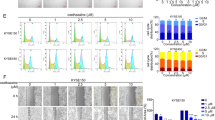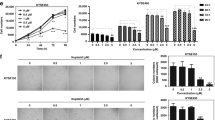Abstract
Esophageal squamous cell carcinoma (ESCC) is one of the leading causes of cancer death worldwide. It is urgent to develop new drugs to improve the prognosis of ESCC patients. Here, we found benzydamine, a locally acting non-steroidal anti-inflammatory drug, had potent cytotoxic effect on ESCC cells. Benzydamine could suppress ESCC proliferation in vivo and in vitro. In terms of mechanism, CDK2 was identified as a target of benzydamine by molecular docking, pull-down assay and in vitro kinase assay. Specifically, benzydamine inhibited the growth of ESCC cells by inhibiting CDK2 activity and affecting downstream phosphorylation of MCM2, c-Myc and Rb, resulting in cell cycle arrest. Our study illustrates that benzydamine inhibits the growth of ESCC cells by downregulating the CDK2 pathway.
Similar content being viewed by others
References
Yuan Z, Wang X, Geng X, Li Y, Mu J, Tan F, Xue Q, Gao S, He J. Liquid biopsy for esophageal cancer: is detection of circulating cell-free DNA as a biomarker feasible? Cancer Commun (Lond) 2021; 41(1): 3–15
Abnet CC, Arnold M, Wei WQ. Epidemiology of esophageal squamous cell carcinoma. Gastroenterology 2018; 154(2): 360–373
Yang YM, Hong P, Xu WW, He QY, Li B. Advances in targeted therapy for esophageal cancer. Signal Transduct Target Ther 2020; 5(1): 229
di Pietro M, Canto MI, Fitzgerald RC. Endoscopic management of early adenocarcinoma and squamous cell carcinoma of the esophagus: screening, diagnosis, and therapy. Gastroenterology 2018; 154(2): 421–436
Reichenbach ZW, Murray MG, Saxena R, Farkas D, Karassik EG, Klochkova A, Patel K, Tice C, Hall TM, Gang J, Parkman HP, Ward SJ, Tétreault MP, Whelan KA. Clinical and translational advances in esophageal squamous cell carcinoma. Adv Cancer Res 2019; 144: 95–135
Surh YJ. Cancer chemoprevention with dietary phytochemicals. Nat Rev Cancer 2003; 3(10): 768–780
Desai P, Thumma NJ, Wagh PR, Zhan S, Ann D, Wang J, Prabhu S. Cancer chemoprevention using nanotechnology-based approaches. Front Pharmacol 2020; 11: 323
Ranjan A, Ramachandran S, Gupta N, Kaushik I, Wright S, Srivastava S, Das H, Srivastava S, Prasad S, Srivastava SK. Role of phytochemicals in cancer prevention. Int J Mol Sci 2019; 20(20): 4981
Chen CY, Kuo CJ, Lee YW, Lam F, Tam KW. Benzydamine hydrochloride on postoperative sore throat: a meta-analysis of randomized controlled trials. Can J Anaesth 2014; 61(3): 220–228
Faber EB, Wang N, Georg GI. Review of rationale and progress toward targeting cyclin-dependent kinase 2 (CDK2) for male contraception†. Biol Reprod 2020; 103(2): 357–367
Fagundes R, Teixeira LK. Cyclin E/CDK2: DNA replication, replication stress and genomic instability. Front Cell Dev Biol 2021; 9: 774845
Tetsu O, McCormick F. Proliferation of cancer cells despite CDK2 inhibition. Cancer Cell 2003; 3(3): 233–245
Au-Yeung G, Lang F, Azar WJ, Mitchell C, Jarman KE, Lackovic K, Aziz D, Cullinane C, Pearson RB, Mileshkin L, Rischin D, Karst AM, Drapkin R, Etemadmoghadam D, Bowtell DDL. Selective targeting of cyclin E1-amplified high-grade serous ovarian cancer by cyclin-dependent kinase 2 and AKT inhibition. Clin Cancer Res 2017; 23(7): 1862–1874
Tadesse S, Anshabo AT, Portman N, Lim E, Tilley W, Caldon CE, Wang S. Targeting CDK2 in cancer: challenges and opportunities for therapy. Drug Discov Today 2020; 25(2): 406–413
Tadesse S, Caldon EC, Tilley W, Wang S. Cyclin-dependent kinase 2 inhibitors in cancer therapy: an update. J Med Chem 2019; 62(9): 4233–4251
Gfeller D, Grosdidier A, Wirth M, Daina A, Michielin O, Zoete V. SwissTargetPrediction: a web server for target prediction of bioactive small molecules. Nucleic Acids Res 2014; 42: W32–W38
Grosdidier A, Zoete V, Michielin O. SwissDock, a protein-small molecule docking web service based on EADock DSS. Nucleic Acids Res 2011; 39: W270–W277
Wang Z, Jensen MA, Zenklusen JC. A practical guide to The Cancer Genome Atlas (TCGA). Methods Mol Biol 2016; 1418: 111–141
Hu Y, Liu F, Jia X, Wang P, Gu T, Liu H, Liu T, Wei H, Chen H, Zhao J, Yang R, Chen Y, Dong Z, Liu K. Periplogenin suppresses the growth of esophageal squamous cell carcinoma in vitro and in vivo by targeting STAT3. Oncogene 2021; 40(23): 3942–3958
Jiang Y, Wu Q, Yang X, Zhao J, Jin Y, Li K, Ma Y, Chen X, Tian F, Zhao S, Xu J, Lu J, Yin X, Liu K, Dong Z. A method for establishing a patient-derived xenograft model to explore new therapeutic strategies for esophageal squamous cell carcinoma. Oncol Rep 2016; 35(2): 785–792
Jin G, Yan M, Liu K, Yao K, Chen H, Zhang C, Yi Y, Reddy K, Gorja DR, Laster KV, Guo Z, Dong Z. Discovery of a novel dual-target inhibitor against RSK1 and MSK2 to suppress growth of human colon cancer. Oncogene 2020; 39(43): 6733–6746
Sürmen MG, Sürmen S, Ali A, Musharraf SG, Emekli N. Phosphoproteomic strategies in cancer research: a minireview. Analyst (Lond) 2020; 145(22): 7125–7149
Ma J, Chen T, Wu S, Yang C, Bai M, Shu K, Li K, Zhang G, Jin Z, He F, Hermjakob H, Zhu Y. iProX: an integrated proteome resource. Nucleic Acids Res 2019; 47(D1): D1211–D1217
Kanehisa M, Furumichi M, Tanabe M, Sato Y, Morishima K. KEGG: new perspectives on genomes, pathways, diseases and drugs. Nucleic Acids Res 2017; 45(D1): D353–D361
Burley SK, Berman HM, Kleywegt GJ, Markley JL, Nakamura H, Velankar S. Protein Data Bank (PDB): the single global macromolecular structure archive. Methods Mol Biol 2017; 1607: 627–641
Trott O, Olson AJ. AutoDock Vina: improving the speed and accuracy of docking with a new scoring function, efficient optimization, and multithreading. J Comput Chem 2010; 31(2): 455–461
Sung H, Ferlay J, Siegel RL, Laversanne M, Soerjomataram I, Jemal A, Bray F. Global cancer statistics 2020: GLOBOCAN estimates of incidence and mortality worldwide for 36 cancers in 185 countries. CA Cancer J Clin 2021; 71(3): 209–249
Cioli V, Corradino C, Scorza Barcellona P. Review of pharmacological data on benzydamine. Int J Tissue React 1985; 7(3): 205–213
Quane PA, Graham GG, Ziegler JB. Pharmacology of benzydamine. Inflammopharmacology 1998; 6(2): 95–107
Singh NP, Makkar JK, Wourms V, Singh PM. Topical benzydamine for preventing postoperative sore throat. Anaesthesia 2018; 73(10): 1297
Worthington H V., Clarkson JE, Bryan G, Furness S, Glenny AM, Littlewood A, McCabe MG, Meyer S, Khalid T, Riley P. Interventions for preventing oral mucositis for patients with cancer receiving treatment. Cochrane database Syst Rev 2011; 2011(4): CD000978
Golsteyn RM. Cdk1 and Cdk2 complexes (cyclin dependent kinases) in apoptosis: a role beyond the cell cycle. Cancer Lett 2005; 217(2): 129–138
Tsuji T, Ficarro SB, Jiang W. Essential role of phosphorylation of MCM2 by Cdc7/Dbf4 in the initiation of DNA replication in mammalian cells. Mol Biol Cell 2006; 17(10): 4459–4472
Poon RYC. Cell cycle control: a system of interlinking oscillators. Methods Mol Biol 2016; 1342: 3–19
Harbour JW, Luo RX, Santi AD, Postigo AA, Dean DC. Cdk phosphorylation triggers sequential intramolecular interactions that progressively block Rb functions as cells move through G1. Cell 1999; 98(6): 859–869
Hydbring P, Larsson LG. Tipping the balance: Cdk2 enables Myc to suppress senescence. Cancer Res 2010; 70(17): 6687–6691
Hydbring P, Castell A, Larsson LG. MYC modulation around the CDK2/p27/SKP2 axis. Genes (Basel) 2017; 8(7): 174
Garcia PL, Miller AL, Yoon KJ. Patient-derived xenograft models of pancreatic cancer: overview and comparison with other types of models. Cancers (Basel) 2020; 12(5): 1327
Klöß S, Dehmel S, Braun A, Parnham MJ, Köhl U, Schiffmann S. From cancer to immune-mediated diseases and tolerance induction: lessons learned from immune oncology and classical anti-cancer treatment. Front Immunol 2020; 11: 1423
Hidalgo M, Amant F, Biankin AV, Budinská E, Byrne AT, Caldas C, Clarke RB, de Jong S, Jonkers J, Mælandsmo GM, RomanRoman S, Seoane J, Trusolino L, Villanueva A. Patient-derived xenograft models: an emerging platform for translational cancer research. Cancer Discov 2014; 4(9): 998–1013
Nielsen TO, Leung SCY, Rimm DL, Dodson A, Acs B, Badve S, Denkert C, Ellis MJ, Fineberg S, Flowers M, Kreipe HH, Laenkholm AV, Pan H, Penault-Llorca FM, Polley MY, Salgado R, Smith IE, Sugie T, Bartlett JMS, McShane LM, Dowsett M, Hayes DF. Assessment of Ki67 in breast cancer: updated recommendations from the international Ki67 in breast cancer working group. J Natl Cancer Inst 2021; 113(7): 808–819
Acknowledgments
This work was supported by the National Natural Science Foundations of China (No. 81872335), the National Natural Science Youth Foundation (No. 81902486), the Natural Science Foundation of Henan (No. 161100510300), the Central Plains Science and Technology Innovation Leading Talents (No. 224200510015), the Science and Technology Project of Henan Province (No. 212102310187).
Author information
Authors and Affiliations
Corresponding authors
Ethics declarations
Yubing Zhou, Xinyu He, Yanan Jiang, Zitong Wang, Yin Yu, Wenjie Wu, Chenyang Zhang, Jincheng Li, Yaping Guo, Xinhuan Chen, Zhicai Liu, Jimin Zhao, Kangdong Liu and Zigang Dong declare no competing interests. This study was approved by the Research Ethics Committee of Zhengzhou University. Written informed consent was provided by all patients for the use of the tissue samples.
Supplementary Figures
Rights and permissions
About this article
Cite this article
Zhou, Y., He, X., Jiang, Y. et al. Repurposed benzydamine targeting CDK2 suppresses the growth of esophageal squamous cell carcinoma. Front. Med. 17, 290–303 (2023). https://doi.org/10.1007/s11684-022-0956-8
Received:
Accepted:
Published:
Issue Date:
DOI: https://doi.org/10.1007/s11684-022-0956-8




